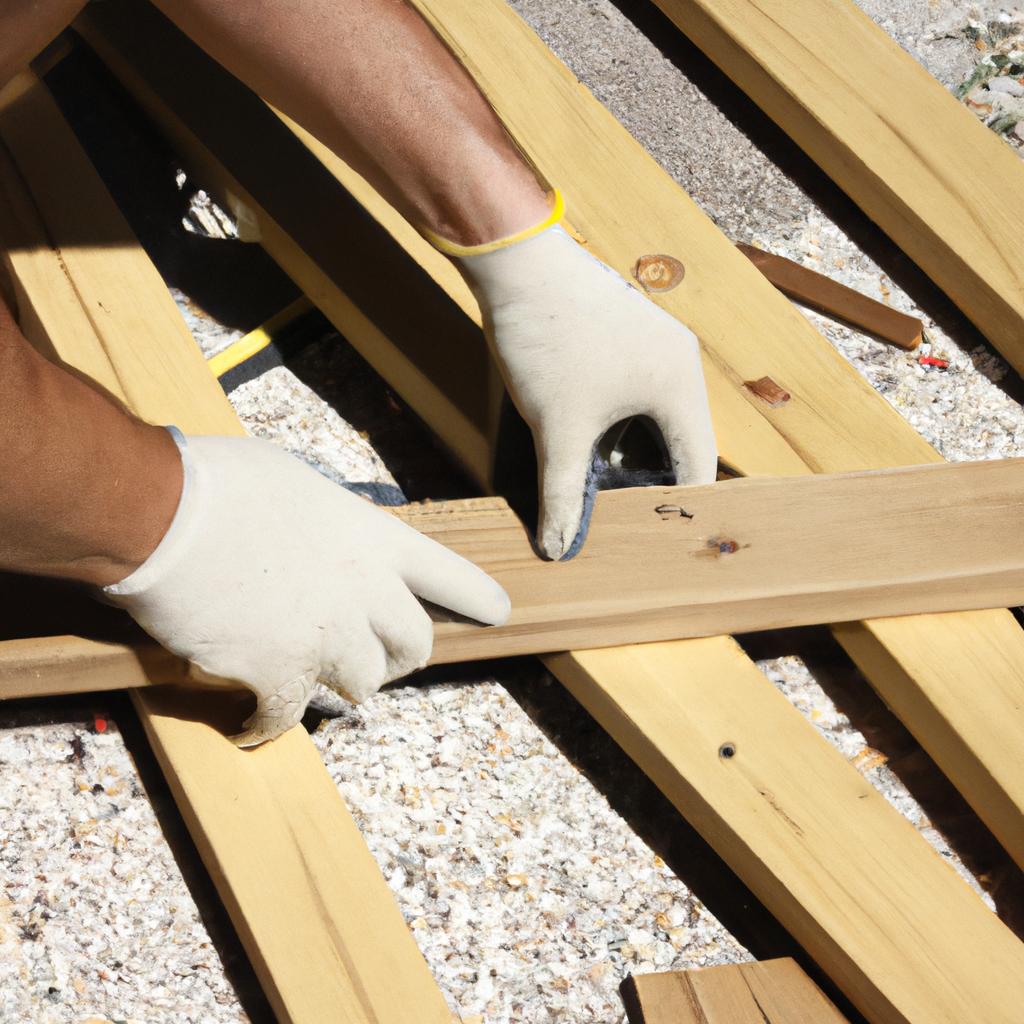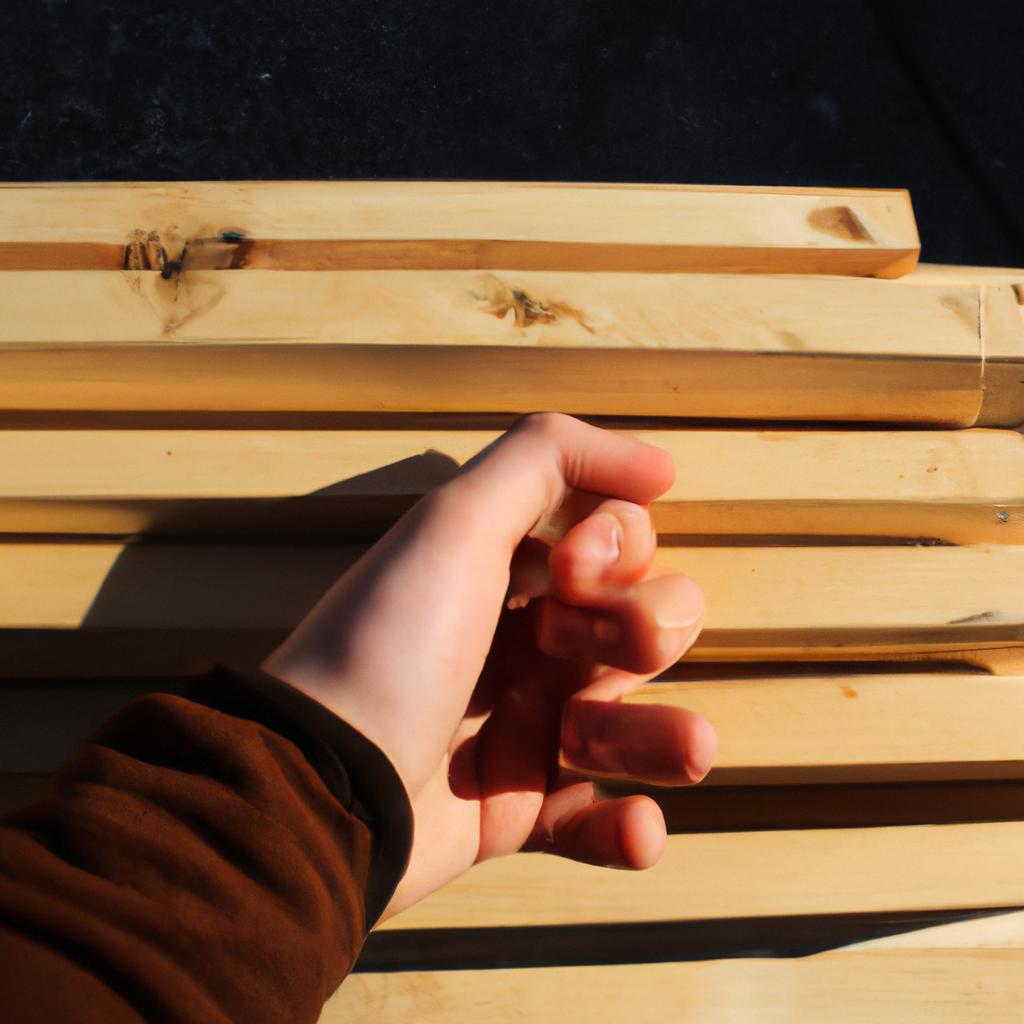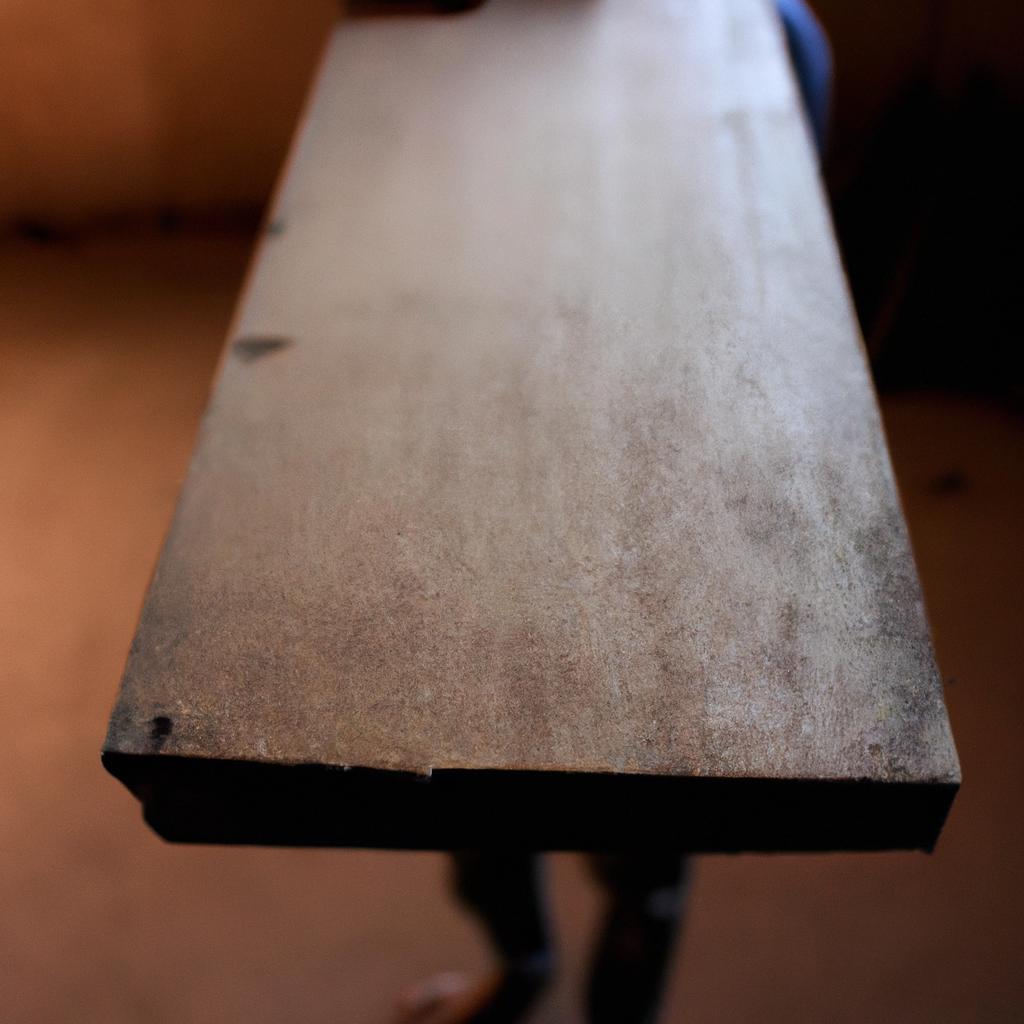Wood studs are a fundamental component in the construction industry, serving as essential structural elements in various building projects. With their versatility and strength, wood studs offer a wide range of uses that make them indispensable for builders and architects alike. For instance, consider a hypothetical scenario where an architect is designing a residential house. The use of wood studs becomes crucial in this case to provide stability and support to the overall structure.
The primary function of wood studs is to serve as vertical supports within walls, providing rigidity and load-bearing capabilities. These sturdy pieces of lumber are typically installed at regular intervals and form the framework upon which other building materials can be attached. Wood studs act as the backbone of walls, ensuring they remain stable while withstanding external forces such as wind or seismic activity.
Apart from their structural role, wood studs also contribute to insulation properties by creating cavities within walls where insulation material can be placed. This enhances energy efficiency by reducing heat transfer between indoor and outdoor environments. Additionally, these cavities allow for easy installation of electrical wiring and plumbing systems, making wood studs pivotal for both functionality and aesthetics in modern constructions.
In summary, wood studs play a vital role in the realm of construction through their multiple applications. From offering structural support to facilitating insulation and utility installation, wood studs are indispensable components in building projects. Their strength, versatility, and ability to create stable frameworks make them essential for architects and builders alike. Whether it’s a residential house or a commercial building, wood studs provide the necessary stability and support to ensure the overall structure’s integrity. Additionally, they contribute to energy efficiency by creating cavities for insulation material while allowing easy installation of electrical wiring and plumbing systems. Without wood studs, modern constructions would lack the necessary structural integrity and functionality they require.
Framing walls in residential and commercial construction
Wood studs are a fundamental component of wall framing in both residential and commercial construction. They provide structural support, stability, and allow for the creation of interior spaces. For instance, consider the case of a new housing development where wood studs were used to frame the walls of each house. This allowed for efficient construction while ensuring durability and flexibility in design.
One common application of wood studs is in creating load-bearing walls that carry the weight of the structure above them. These walls serve as essential elements in maintaining the integrity and stability of buildings. Wood studs offer excellent strength-to-weight ratio, making them suitable for this purpose.
Furthermore, wood studs are widely utilized in non-load-bearing partition walls, which divide space within a building. These partitions contribute to creating functional rooms or sections with specific purposes. By using wood studs for such divisions, contractors can easily customize layouts based on client requirements or changing needs over time.
To emphasize their importance further, here are some key benefits of using wood studs for framing walls:
- Durability: Wood studs have proven long-term performance when properly installed and maintained.
- Sustainability: As a renewable resource, wood contributes to environmentally friendly construction practices.
- Thermal insulation: The inherent properties of wood help regulate temperature fluctuations within buildings.
- Soundproofing: Wood absorbs sound vibrations more effectively compared to other materials.
The following table highlights some advantages offered by wood studs when compared to alternative materials:
| Advantage | Wood Studs | Alternative Materials |
|---|---|---|
| Cost-effectiveness | :white_check_mark: | :x: |
| Ease of installation | :white_check_mark: | :x: |
| Flexibility | :white_check_mark: | :x: |
| Sustainable choice | :white_check_mark: | :x: |
As we transition into discussing “Creating partitions and room dividers,” it is evident that wood studs play a crucial role in framing walls for various construction applications. They provide structural support, flexibility in design, and contribute to the overall functionality of buildings.
Creating partitions and room dividers
From framing walls to creating partitions, wood studs have a wide range of common uses in both residential and commercial construction. In this section, we will explore another important application of wood studs: creating partitions and room dividers.
Consider a hypothetical scenario where an open-concept office space needs to be divided into smaller sections for individual workstations. Wood studs can be used effectively to create these partitions, providing privacy and separation while maintaining the integrity of the overall design. By strategically placing vertical wood studs at regular intervals and attaching horizontal panels or drywall sheets, sturdy and functional room dividers can be constructed.
Wood studs offer several advantages when it comes to creating partitions and room dividers:
- Versatility: Wood studs can easily accommodate various types of materials such as drywall, paneling, or glass, allowing for diverse design possibilities.
- Soundproofing: When combined with appropriate insulation materials, wood stud partitions can help reduce noise transmission between different areas within a building.
- Customization: Wood studs are highly adaptable, making it possible to create unique partition designs that meet specific spatial requirements.
- Cost-effectiveness: Compared to other alternatives like metal studs or concrete walls, wood studs are generally more affordable without compromising quality.
To further illustrate the potential applications of wood stud partitions, consider the following table showcasing four examples in different settings:
| Setting | Application | Benefits |
|---|---|---|
| Office Space | Creating individual workstations | Privacy, division of workspace |
| Retail Store | Separating merchandise display areas | Clear delineation between product categories |
| Residential Home | Dividing living area from dining area | Separate functional spaces while maintaining openness |
| Educational | Erecting temporary classrooms or study rooms | Quick setup/teardown options; flexibility for changing needs |
As seen from these examples, wood stud partitions offer practical solutions across multiple sectors by effectively dividing spaces and serving specific functional needs.
Moving forward, we will explore yet another application of wood studs in construction: building shelves and storage units. By utilizing the strength and flexibility of wood studs, various creative storage solutions can be achieved to optimize space utilization within buildings.
Building shelves and storage units
Common Uses of Wood Studs: Lumber and Building Materials
Creating partitions and room dividers
Wood studs are commonly used in construction to create partitions and room dividers. For instance, imagine a large open space that needs to be divided into individual rooms or office spaces. By installing wood studs vertically between the floor and ceiling, it becomes possible to separate the area into distinct sections without resorting to more permanent structures like concrete walls.
These divisions allow for flexibility in space utilization, as they can easily be modified or removed altogether if needed in the future. Additionally, wood studs provide an excellent framework for mounting doors, windows, and other fixtures required within each partitioned area.
Building shelves and storage units
Another common use of wood studs is in constructing shelves and storage units. Consider a home workshop where tools need organized placement. Utilizing sturdy wooden studs as the supporting structure for shelves allows for efficient organization while maximizing available vertical space.
Here are some benefits of using wood studs for building shelves:
- Strength and durability: Wood studs offer stability when supporting heavy items such as books or toolboxes.
- Easy customization: The dimensions of the shelf can be adjusted by cutting the stud accordingly.
- Cost-effective solution: Compared to purchasing pre-made shelving units, utilizing wood studs is often less expensive.
- Versatility: With creativity and proper craftsmanship, various configurations can be designed to suit specific storage needs.
Constructing outdoor decks and fences

Moving on from indoor applications, wood studs are also widely employed in constructing outdoor decks and fences. These structures not only enhance the aesthetic appeal of a property but also serve functional purposes such as providing privacy or creating an extended living area outdoors.
By implementing treated wood studs resistant to weather elements, one can construct durable decks capable of withstanding changing seasons’ challenges. Similarly, when combined with horizontal boards or pickets, wood studs form the framework for sturdy and reliable fences that define property boundaries.
In summary, wood studs find diverse applications in various construction projects. From creating partitions and room dividers to building shelves and storage units, these versatile materials provide strength, durability, and customization options. Furthermore, when it comes to outdoor projects like constructing decks and fences, wood studs can withstand environmental factors while adding value and functionality to a property.
Constructing outdoor decks and fences
Building shelves and storage units using wood studs is a common practice that offers durability and versatility. Let’s explore some of the benefits and applications of this approach.
To illustrate the practicality of using wood studs for building shelves, consider the following example: imagine a small home office with limited space. The owner wants to maximize storage while maintaining an aesthetically pleasing environment. By utilizing wood studs, they can create customized shelving units that fit perfectly into their available space, providing ample room for books, files, and other items. This case study demonstrates how efficiently utilizing wood studs can help optimize organization in various settings.
Here are several key reasons why wood studs are frequently chosen for constructing shelves and storage units:
- Strength: Wood studs possess excellent load-bearing capabilities, making them ideal for supporting heavy objects such as books or electronic equipment.
- Flexibility: With wood studs, it is easy to adjust shelf heights according to specific needs. This allows for increased adaptability when storing items of varying sizes.
- Cost-effectiveness: Compared to alternative materials like metal or plastic, wood studs tend to be more affordable without compromising on quality.
- Aesthetic appeal: Wood adds warmth and natural beauty to any space, enhancing its visual appeal.
To further emphasize these advantages, let us examine a table comparing different materials used for building shelves:
| Material | Strength | Flexibility | Cost-effectiveness | Aesthetic Appeal |
|---|---|---|---|---|
| Wood Studs | High | Adjustable | Affordable | Warm & Natural |
| Metal | High | Limited | Expensive | Industrial |
| Plastic | Moderate | Flexible | Inexpensive | Modern |
As we can see from the above comparison table, wood studs excel in terms of strength and cost-effectiveness while also offering flexibility and aesthetic appeal—a combination that makes them a popular choice for building shelves and storage units.
Transitioning to the next section, making furniture and cabinetry is another common application of wood studs. By utilizing their inherent qualities such as strength and versatility, wood studs can be transformed into functional and visually appealing pieces that enhance any living or working space.
Making furniture and cabinetry
Constructing outdoor decks and fences using wood studs is just one of the many common uses for this versatile building material. Another popular application involves making furniture and cabinetry. Let’s explore how wood studs are utilized in these areas.
To illustrate the potential of wood studs in furniture construction, consider a hypothetical scenario where a skilled carpenter builds a beautiful dining table from scratch. The sturdy frame of the table is constructed using high-quality wood studs that provide excellent support and stability. The tabletop itself may be made from another type of lumber or even a different material altogether, but it is the underlying framework created with wood studs that gives the table its solid structure.
Wood studs also play an essential role in cabinet-making. Cabinets need to withstand daily use while providing ample storage space. By utilizing wood studs as the foundation for cabinets, craftsmen can create durable structures capable of supporting heavy loads. These sturdy frames ensure that the cabinets maintain their shape over time and resist warping or sagging.
In addition to constructing furniture and cabinetry, here are some other notable applications of wood studs:
- Building interior walls: Wood studs are commonly used to construct partition walls within homes and buildings.
- Creating shelving units: Wood stud frameworks make it possible to build strong shelves suitable for storing books, decorative items, or household essentials.
- Designing display cases: Showcasing valuable collectibles or merchandise often requires custom-built display cases featuring wooden stud frames.
- Crafting artistic installations: Artists and designers often employ wood studs as structural elements when creating large-scale art installations or sculptures.
These examples demonstrate just a few instances where wood studs prove invaluable in various projects. Whether it’s constructing furniture, partitions, shelving units, or creative displays, incorporating wood studs ensures durability, strength, and reliability.
Moving forward into our next section about supporting drywall and other finishing materials
Supporting drywall and other finishing materials
Common Uses of Wood Studs: Supporting Drywall and Other Finishing Materials
After exploring the various applications of wood studs in making furniture and cabinetry, we now turn our attention to another important use: supporting drywall and other finishing materials. Wood studs play a crucial role in providing structural integrity and stability for these elements within buildings. Let us delve into this topic further.
To illustrate the significance of wood studs in supporting drywall and other finishing materials, consider the following example. Imagine a newly constructed residential building where the interior walls are being finished with drywall panels. The installation process involves attaching these panels to wood studs that have been securely anchored to the wall frame. By using wood studs as a framework, builders ensure that the weight of the drywall is evenly distributed across the surface, preventing sagging or cracking over time.
Wood studs offer several advantages when it comes to supporting drywall and other finishing materials:
- Durability: Wood studs provide sturdy support for heavy materials like drywall, ensuring long-lasting construction.
- Versatility: They can be easily cut and adjusted to fit different dimensions and layouts, accommodating custom designs or architectural features.
- Insulation properties: Wood has natural insulation properties, helping reduce heat transfer through walls while enhancing energy efficiency.
- Soundproofing capabilities: The solid nature of wood studs helps dampen sound transmission between rooms, creating a sense of privacy and tranquility.
Let’s take a closer look at how wood studs compare to alternative materials commonly used for supporting finishing materials:
| Material | Advantages | Disadvantages |
|---|---|---|
| Wood | Natural aesthetics | Potential susceptibility to moisture damage |
| Steel | High strength-to-weight ratio | Vulnerable to corrosion if not properly protected |
| Aluminum | Lightweight | Weaker compared to steel or wood |
In summary, wood studs serve an essential purpose in supporting drywall and other finishing materials within buildings. Their durability, versatility, insulation properties, and soundproofing capabilities make them a preferred choice for construction projects. While alternative materials like steel or aluminum offer certain advantages, wood remains an excellent option due to its natural aesthetics and ability to provide reliable support. By utilizing wood studs effectively, builders can ensure the stability and longevity of interior finishes, creating functional and aesthetically pleasing spaces.
(Note: Table formatting might not appear correctly as markdown format is not supported here.)
 Bergmann Lumber
Bergmann Lumber



